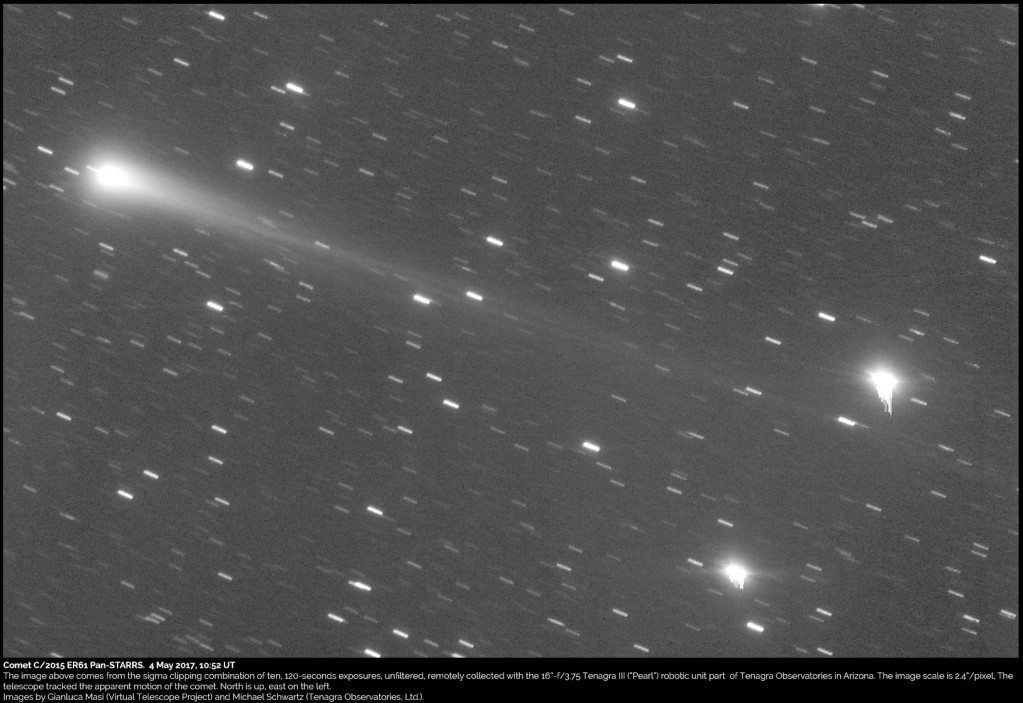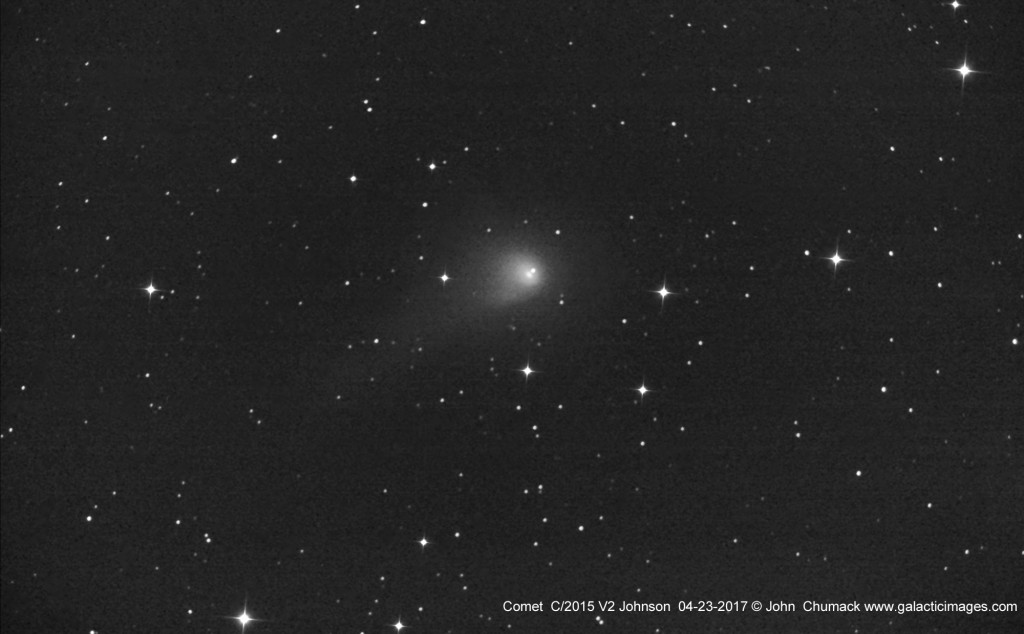ALPO COMET NEWS FOR JUNE 2017
2017-May-31
The nights may be getting shorter but they sure are warmer (and probably buggier as well). Two comets are nice and bright for June observers. C/2015 V2 (Johnson) is now 7th magnitude and visible for much of the night. Another long-period comet, C/2015 ER61 (PANSTARRS) is around 8th magnitude but only visible before dawn. For larger aperture observers, quickly fading 41P/Tuttle-Giacobini-Kresak and 10th magnitude 71P/Clark are also visible.
Last month the Comet Section received comet magnitude estimates for comets 41P/Tuttle-Giacobini-Kresak, C/2015 ER61 (PANSTARRS) and C/2015 V2 (Johnson) from Salvador Aguirre, Carl Hergenrother and Willian Souza. CCD images were received for comets 45P/Honda-Mrkos-Pajdusakova, C/2015 ER61 (PANSTARRS) and C/2015 V2 (Johnson) from Gianluca Masi, Richard Owens, John D. Sabia, Chris Schur and Michael Schwartz.
Evening C0mets
C/2015 V2 (Johnson) [Perihelion on 2017 June 12 at 1.64 au]
Comet Johnson will be at its best this month as it passes perihelion on June 12 at 1.64 au and closest approach to Earth on June 5 at 0.81 au. The comet is well placed and can be observed as soon as it gets dark in the evening. The comet starts the month a few degrees to the northeast of Arcturus and moves south during the month [Bootes (Jun 1-14) and Virgo (14-30)]. Currently between magnitude 7.5 and 8.0, the comet is an easy object for binocular and small telescope users. It should remain nearly as bright for most of the month through it may start to fade as it moves away from the Sun (1.64 to 1.66 au) and Earth (0.81 to 0.95 au).
C/Johnson was first seen back in November 2015 when it was 17th magnitude and located 6.5 au from the Sun. The fact that it was so bright when so far from the Sun suggests a large amount of dust was released in the years prior to discovery. This is rather typical of dynamically new comets making their first trip through the inner solar system. Dynamically new comets also usually brighten at a slow rate. While there was some hope it would brighten to 5th – 6th magnitude it looks like its current 7th magnitude is as bright as it willl get. All of that dust released over the past few years has provided Johnson with a nice bright dust tail. On June 1, the Earth is in line with Johnson’s orbit plane making the dust tail even more pronounced. The image below was taken by Chris Schur on May 28 and shows two tails pointing nearly 180 degrees apart (the broad bright dust tail to the lower left and a narrower fainter gas tail to the upper right).
71P/Clark [Perihelion on 2017 June 30 at 1.59 au]
Michael Clark discovered this comet photographically in 1973 from Mount John University Observatory in New Zealand. With an orbital period of 5.6 years, 2017 marks Clark’s 8th observed return. It spends the entire month in Scorpius (starting a few degrees to the southeast of Antares and moving slowly south from there). Its distance from the Sun is slowly decreasing as it approaches perihelion at 1.59 au on June 30. The comet will come as close to the Earth as it can on its present orbit on June 11 at 0.59 au. It is currently between magnitude 10.5 and 11.0 and should get a little brighter this month.
Morning Comets
41P/Tuttle-Giacobini-Kresak [Perihelion on 2017 Apr 12 at 1.05 au]
Now about 2 months removed from its close approach to Earth in April, 41P/T-G-K is currently between magnitude 9.5 and 10.0 and may fade to 13-14 by the end of the month. Unfortunately it did not experience one of its famous 10 magnitude outbursts. At least not yet. This month 41P will move through Hercules (Jun 1-4), Ophiuchus (4-13), Serpens Cauda (13-15), Ophiuchus (15-24) and Serpens Cauda (24-30) as it moves away from the Sun (1.24 to 1.47 au) and Earth (0.29 to 0.47 au). It is a morning object all month with an elongation that increases from 134 to 159 degrees. It starts the month between magnitude 9.5 and 10.0 and may fade to 13-14 by the end of the month.
C/2015 ER61 (PANSTARRS) [Perihelion on 2017 May 9 at 1.04 au]
June’s other long-period comet is C/2015 ER61 (PANSTARRS). It reached perihelion on May 9 at 1.04 au from the Sun and is moving away from the Sun (1.11 to 1.35 au) and Earth (1.38 to 1.56 au). Back in April, it experienced a 2 magnitude outburst. Since then the comet has settled back down and is currently 8th magnitude. Due to its increasing distance to the Sun and Earth it will slowly fade this month to 9th magnitude. All month, ER61 is a morning object moving through Pisces (Jun 1-15) and Aries (15-30).
Other Comets in the News
Newly discovered C/2017 K2 (PANSTARRS) is a bit of an enigma. Currently located 16 au from the Sun, K2 will not reach perihelion at 1.7 au until 2023! Extrapolating its current brightness results in a 5th magnitude comet for almost half of 2023. The main problem (actually there are a few) is that K2 is on a Halley-type with a 125 year period. If K2 were just as bright 125 or so years ago it would have been easily discovered. Perhaps the comet is experiencing an outburst. Only time, and monitoring, will tell.
As always, the Comet Section is happy to receive all comet observations, whether images, drawings or magnitude estimates.
- Carl Hergenrother (ALPO Comet Section Coordinator)








